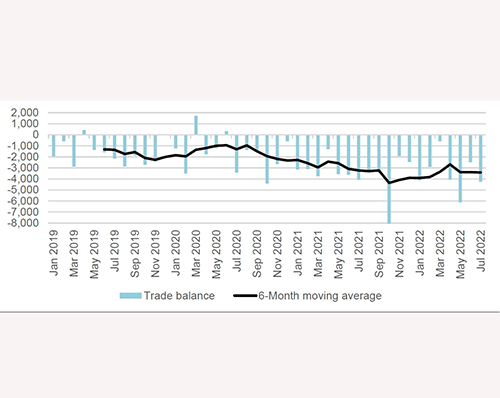For the month of July 2022, Namibia recorded a trade deficit to the tune of N$4.3 billion, reflecting a worsened trade deficit when compared to N$2.5 billion recorded in June 2022, and N$3.6 billion recorded in July 2021.
A trade deficit is defined as the amount by which the cost of a country’s imports exceeds the value of its exports.
The latest trade figures from the Namibia Statistics Agency (NSA) indicate that between July 2021 to July 2022, Namibia recorded a deficit averaging N$3.3 billion without recording any surplus. A trade balance compares the country’s trade flow with the rest of the world in terms of export earnings and expenditure on
imports.
NSA CEO Alex Shimuafeni said for the month under review, the country’s export earnings stood at N$7.3 billion, down by 14.8% on a monthly basis, while the imports bill amounted to N$11.6 billion, up by 4.5% on a monthly basis. This resulted in a worsened trade deficit of N$4.3 billion, representing an increase of 70.9% when compared to N$2.5 billion recorded the previous month.
In the report on July trade statistics released this week, the NSA showed that Namibia’s trade activities continued to increase from January to July 2022 when compared to the same period of 2021.
“Cumulative total trade, import plus export, for the month of July 2022 stood at N$127.1 billion, representing an increase of 51.2% from N$84.1 billion recorded during the same period in 2021,” Shimuafeni stated.
Furthermore, precious stones (diamonds) were Namibia’s largest export commodity during July 2022, accounting for 25.3% of total exports, mostly destined for Botswana, Hong Kong and South Africa. This was followed by fish, which accounted for 10.6% of total exports, destined mostly for Spain and Zambia. Uranium came in third on the list with a share of 7.5%, and was exclusively destined for China.
Looking to imported goods, in July 2022, the value of imports into the country amounted to N$11.6 billion, an increase of 4.5% when compared to N$11.1 billion recorded in June 2022, and an increase of 60.1% from N$7.2 billion when compared to the same month in the previous year.
“The top five commodities imported into Namibia accounted for 43.9% of total imports, with petroleum oils being the highest imported commodity for the month of July 2022, accounting for a share of 18% of the nation’s total import value. These were mainly sourced from Oman, India and the United Arab Emirates,” reads the report.
It added that during the month under review, the country imported tomatoes worth N$24.6 million, thus making it the product of the month. Over the entire period, the import value of this commodity averaged N$9.4 million a month, with the largest import value of N$24.6 million recorded in July 2022, while no tomatoes were imported in December 2021. Tomatoes imported in the month under review were sourced from South Africa. When compared to the corresponding month of last year, the import value of tomatoes for July 2022 increased by a notable
251.1%.
Commenting on the most recent figures, economist at Simonis Storm Theo Klein noted that Namibia’s exports nearly doubled in July 2022 from 12 months ago, rising by 99.6% year-on-year (y/y). During the same time, imports increased by 60.1% y/y.
“Going forward, a deteriorating global outlook will weigh heavily on Namibia’s export potential. The latest manufacturing Purchasing Managers Indices (PMIs) from Namibia’s main trading partners are on a downward trend. One of the main categories driving PMIs lower is a decline in export orders, taking manufacturing PMIs closer to the critical 50 index level, which indicates contractions are more likely,” he stated.
The economist added that the declining trend in the Eurozone, United Kingdom and the United States suggests a deceleration in activity in these advanced economies.
Said Klein: “Similarly, domestic demand is likely to remain subdued, with Namibia’s GDP projected to grow by a modest 2.5% in 2022, weighing on import activity. However, inflationary effects are likely to keep the value of imports above exports for the remainder of the year, leading to further trade deficits”.


